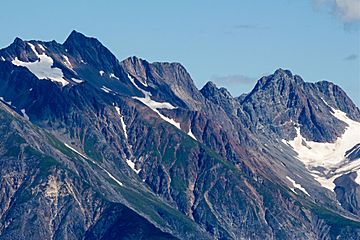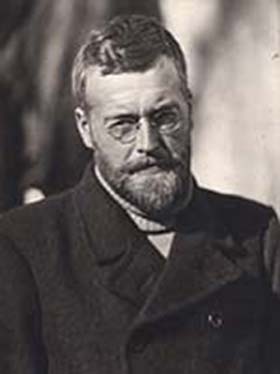Mount Wordie facts for kids
Quick facts for kids Mount Wordie |
|
|---|---|

Mount Wordie, west aspect
(summit at upper left) |
|
| Highest point | |
| Elevation | 4,700 ft (1,400 m) |
| Prominence | 1,046 ft (319 m) |
| Isolation | 1.28 mi (2.06 km) |
| Parent peak | Mount Merriam (5,083 ft) |
| Geography | |
| Location | Glacier Bay National Park Hoonah-Angoon Alaska, United States |
| Parent range | Takhinsha Mountains Alsek Ranges Saint Elias Mountains |
| Topo map | USGS Mount Fairweather D-2 |
| Climbing | |
| Easiest route | South slope, West ridge |
Mount Wordie is a mountain in southeast Alaska, standing over 4,700 feet (1,433 meters) tall. It is located inside Glacier Bay National Park and Preserve. This park is part of the Alsek Ranges within the larger Saint Elias Mountains.
The mountain is about 80 miles (129 km) northwest of Juneau, Alaska's capital city. It sits about 4 miles (6 km) south of Carroll Glacier. Mount Wordie is also 3.1 miles (5 km) north of Mount Merriam, which is a taller peak nearby. Even though Mount Wordie isn't the tallest mountain, it rises very steeply from the water. It goes from sea level to its full height in less than two miles. This makes it look very impressive!
The mountain was named in 1941 during an expedition to Glacier Bay. It honors James Mann Wordie (1889-1962). He was a Scottish polar explorer and a geologist who studied glaciers. He even served as the President of the Royal Geological Society from 1951 to 1954. James Wordie visited the nearby Muir Glacier in Glacier Bay back in 1913.
If the weather is clear, you can see Mount Wordie from Queen Inlet and Wachusett Inlet. These are popular spots in Glacier Bay where many cruise ships visit. The best time to see or even climb Mount Wordie is usually from May through June. This is when the weather is most favorable.
| Top - 0-9 A B C D E F G H I J K L M N O P Q R S T U V W X Y Z |
What is Mount Wordie?
Mount Wordie is a mountain peak in a very special part of Alaska. It's located in Glacier Bay National Park and Preserve. This park is famous for its huge glaciers, tall mountains, and beautiful fjords. A fjord is a long, narrow, deep inlet of the sea between high cliffs.
The mountain is part of two mountain ranges: the Alsek Ranges and the Saint Elias Mountains. These ranges are known for having some of the tallest peaks in North America. Mount Wordie itself stands at an impressive height of over 4,700 feet (1,433 meters).
Where is Mount Wordie Located?
Mount Wordie is in the southeastern part of Alaska, United States. It's specifically within the Hoonah-Angoon Census Area. This area is mostly wilderness and includes a large part of Glacier Bay National Park.
To give you an idea of its location:
- It's about 80 miles (129 km) northwest of Juneau, the capital city of Alaska.
- It's about 4 miles (6 km) south of a large ice mass called the Carroll Glacier.
- It's also close to another mountain, Mount Merriam, which is slightly taller.
One cool thing about Mount Wordie is how quickly it rises from the sea. It goes from the water's edge to its high peak in less than two miles. This dramatic rise makes it a very noticeable feature in the landscape.
Why is it Called Mount Wordie?
The mountain got its name in 1941. It was named after a famous person named James Mann Wordie. He was born in Scotland in 1889 and lived until 1962.
James Wordie was a very important person in the world of exploration and science:
- He was a polar explorer. This means he traveled to the Earth's coldest regions, like the Arctic and Antarctic.
- He was also a geologist, someone who studies rocks and the Earth's physical structure. He specialized in glaciers.
- He even became the President of the Royal Geological Society, a very respected group of geologists, from 1951 to 1954.
James Wordie actually visited the Glacier Bay area in 1913. He explored the Muir Glacier, which is another famous glacier in the park. Naming the mountain after him was a way to honor his contributions to science and exploration.
Climate Around Mount Wordie
The climate around Mount Wordie is known as a subarctic climate. This means it has very cold, snowy winters and mild summers.
Here's what the weather can be like:
- During winter, temperatures can drop below −20 °C (which is −4 °F).
- With the wind, it can feel even colder, sometimes below −30 °C (−22 °F).
- A lot of snow and rain falls in this area. This water then flows down from the mountain into the Glacier Bay Basin.
The best time to visit or climb Mount Wordie is usually in May and June. During these months, the weather is often clearer and more pleasant. This makes it easier to see the mountain and enjoy the beautiful scenery of Glacier Bay.



